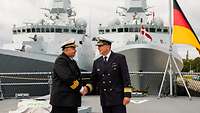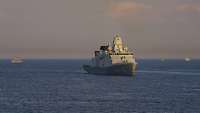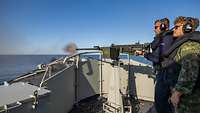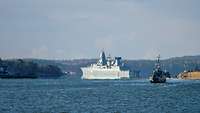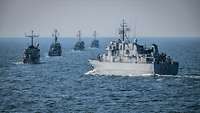Northern Coasts 2023: As realistic as possible
Northern Coasts 2023: As realistic as possible
- Date:
- Place:
- Riga
- Reading time:
- 4 MIN
With the departure of the vessels of the exercise force from Riga on 11 September, the sea phase of Northern Coasts 2023 has begun. This is the actual start of the large-scale naval exercise in the central Baltic Sea, in which around 30 warships from 14 nations are involved.
For the more than 3,000 sailors, marines, and aviators taking part this marks the beginning of an intensive two weeks at sea. In the first week until 18 September, the so-called Combat Enhancement and Force Integration Training will take place. This phase runs along a timetable with many smaller individual exercises, the main aim of which is to ensure that the crews of the vessels are able to work together smoothly. These so-called serials include, for example, sailing in formation, towing at sea or joint defence against attacking aircraft.
“One goal of the exercise is paramount. It is train as you fight,” says Rear Admiral Stephan Haisch. “In other words, the exercise is as close to reality as possible.”
Haisch is commanding the entire exercise formation, Task Force 421. At the same time he is the Exercise Director, i.e. the supreme planner and referee of the large-scale exercise. He and his staff, mainly personnel of the DEU MARFORGerman Maritime Forces command staff, are in charge of the naval exercise off the coasts of Latvia and Estonia led out of Rostock on the German Baltic Sea coast. As Commander Task Force, five individual Task Groups are subordinate to Haisch: two surface action groups with mainly frigates, a large mine-countermeasures group, a formation of long-range reconnaissance aircraft as well as an amphibious group with a large dock-landing ship and a battalion of naval infantry.
German command and control for multinational naval forces
The Admiral explains the following progression of Northern Coasts 2023: “In the second week enter what we call a free-play phase with the Task Groups. Here, we have diligently prepared an exercise script based on existing plans for the collective defence of the Baltic states. Within this framework the units are triggered to actions and reactions by our exercise control based in Rostock.”
This was a special challenge for him and his leadership team in the so-called Exercise Control, he stresses. “We don’t know how the units will react to the script,” says Haisch, yet expressing confidence. “Hopefully, they react as we planned because we have to have our script in mind in general. But it is a free-play and we should trigger a lot of action.”
The importance of the realism of Northern Coasts 2023 is also emphasised by the Chief of the Latvian Navy, Captain Maris Polencs: “The collective defence scenario of Northern Coasts 2023 is essential to optimise interoperability between our naval and air forces involved”. Polencs is also positive: “The scale, complexity, and intensity of the exercise are something to be proud of. We need to be ambitious if we want to achieve our goals.”
The exercise scenario specifically covers defence of the Baltic States
As a representative of the host country Latvia, similar to all countries in the Baltic region, Polencs is particularly aware of the security context of the exercise. “The ongoing war in Ukraine has had a lasting impact on all Baltic states,” he explains. “It has clearly demonstrated the necessity to intensify the cooperation between the Baltic States and regional naval forces.”
There was a well-known Roman proverb, says Polencs: if you wish for peace, prepare for war. “It means that the time to prepare for war is not when the war is imminent,” says the Latvian. “But rather when times are peaceful, it is already time to be prepared.”
For German Exercise Director Stephan Haisch, too, the entire Baltic Sea is in a peaceful normal state. None of the exercise participants anticipates confrontational encounters with, for example, Russian naval vessels during the course of Northern Coasts 2023 or beyond. Moreover, according to media reports, Russia has significantly reduced its exercise activities in the region this year.
Also in view of this, Admiral Haisch once again emphasises the relevance of basics for all those involved in Northern Coasts 2023. “Knowledge of the area, knowledge of the allies and partners, knowledge of the potential opponent and his capabilities and his causes of action are of decisive importance in this particular region of the Baltic Sea,” he elaborates. “Intensive cooperation, permanent coordination, as well as a clear command structure are the key factors for successfully planning and commanding maritime operations.”


